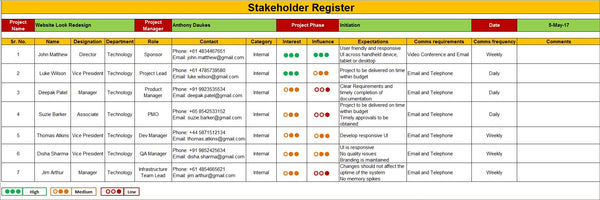Stakeholder Register Template
Stakeholder Register
The first thing to do when a project manager starts managing stakeholders is to know who are the key stakeholders and then document them. This stakeholder register template built in excel helps in documenting all the stakeholders and related information.
What Is A Stakeholder?
A stakeholder is any individual, group, or organization who has any direct or indirect interests in a project and is likely to be affected by the project's outcome. A project can have multiple stakeholders (internal/external), and each stakeholder may have varied interests and expectations from the project. As a Project Manager, it is essential to meet these expectations to ensure that stakeholders are happy. Project stakeholder management is a cornerstone of project success. So check out the article on how to manage, engage stakeholders, and create a plan and a stakeholder analysis template.

Stakeholder Register Template
What Is A Stakeholder Register And Its Purpose?
A stakeholder register is a document used by project managers to capture details on the stakeholders' interests and expectations from the project to help understand their communication requirements. This document lists the names, designation, role in the project, interests, expectations, influence, etc. It is circulated to all stakeholders and should be updated and maintained throughout the project life cycle.
Stakeholder Register Template
- Name – Contains the name of each stakeholder of the project.
- Designation – Notes the Title/Position of the stakeholder (e.g., Director, Vice President, Head of Technology).
- Department – Specifies the department of the stakeholder.
- Role – Defines each stakeholder's roles in a project (e.g., Sponsor, Project Lead, Tester, Product Manager).
- Contact - Contains the phone and email addresses of the stakeholder.
- Category – Specifies the category of the stakeholder (Internal or External to the organization).
- Interests: Denotes the Interest of every stakeholder involved in the project. Every stakeholder has a different level of interest (High/Medium/Low) in a project. Some stakeholders may have High interest while others may have Low interest. For, e.g., If a decision has been made by the Head of Technology to redesign the website of an e-commerce company to adhere to responsive web design guidelines, it calls for the involvement of different teams like the Front End Designer, Developers, Testers, Back End Developers, Network and Infrastructure.
- Influence/Power: This field defines the level of influence of a stakeholder on the project. Some stakeholders like Sponsor have High power as they can influence the decisions. However, in an agile environment, the developers will have a High influence on the decisions being made about the project.
- Expectations: Mentions the expectation a stakeholder has from a project. For, e.g., As a stakeholder, a Project Lead expects the product to be delivered on time.
- Communication requirements: Describes the mode of communication a stakeholder expects. Stakeholders expect regular communication regarding the status of the project, and they may have a preference for the type and mode of communication, which is noted in this column. One stakeholder may prefer communication via Video Conference, while others may prefer an email or Telephone update.
- Frequency: This field mentions the frequency at which the stakeholder expects to receive the communication. While the Sponsor of a project may prefer a weekly/bi-weekly update, another stakeholder may prefer a daily communication.
- Comments: This field can be used to note any additional comments/notes regarding the stakeholder.




